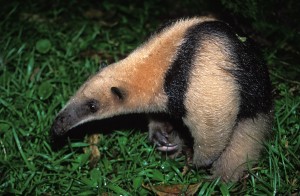Anteaters are unique among land mammals in that they lack teeth and use a long, sticky tongue to slurp up ants and termites. Anteaters are more closely related to sloths than they are to any other group of mammals. Their habitats include dry tropical forest, rainforests, grasslands and savannahs.
They have elongated snouts equipped with a thin tongue that can be extended to a length greater than the length of their head. They have among the lowest body temperature of any mammal. Their eyesight is poor, but strong, heavily clawed forelegs rip open ant nests and a well-developed sense of smell detects their prey.
All four species are restricted to neotropical forests in Central America and South America and three are recorded in Costa Rica. I have been fortunate to see one whilst on a trek in Corcovado National Park. The largest is the rare giant anteater which reaches a length of almost 2m and has a tongue that protrudes an astonishing 60cm up to 150 times a minute! A giant anteater visits up to 200 nests to consume the thousands of insects it needs to satisfy its caloric requirements. Much more common is the lesser anteater which has a distinctive golden-tan and black pattern which has a tongue covered with microscopic back-ward-pointing spines to direct food into its mouth. Graced with a prehensile tail, it is a good tree climber and forages both on and above the ground. It is both nocturnal and diurnal, and if disturbed rears up on its hinds legs and slashes wildly with strong front claws – an intimidating and potentially severe defence. The other Costa Rican species is the 40cm-long silky anteater which is nocturnal and arboreal and eats about 6000 ants per night. By day, it curls up in a tight ball and is hard to see.
Anteaters are mostly solitary animals prepared to defend their territory and rarely enter a territory of another anteater of the same sex.
Lloyd Boutcher,
Director Sunvil Traveller





